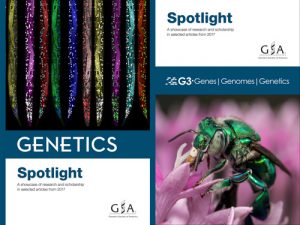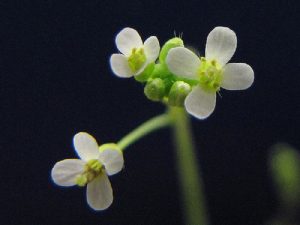Enter your address to receive notifications about new posts to your email.
Articles tagged G3 Journal
(248 results)
-
Antibiotic resistance beyond the hospital
A strain of Staphylococcus epidermidis isolated from a hotel room may provide insight into how resistance develops outside of medical settings. Although intense research and media interest has focused on drug-resistant bacteria in hospital settings, resistance can and does evolve outside the clinic. Methicillin-resistant Staphylococcus epidermidis is often isolated from infections of medical devices, but…
-
Using fruit flies to find rare disease treatments
An automated drug screening approach gives insight into rare NGLY1 deficiency. Sometimes, diagnosing and treating an illness is straightforward. Other times, the diagnosis is challenging while the treatment is simple—or vice versa. In the case of a rare disease like NGLY1 Deficiency, both diagnosis and treatment can feel unreachable. The complex challenges of rare diseases…
-
Remapping lab rats
For the first time in nearly 15 years, the rat genetic map has been updated. Genetic maps help us navigate uncharted data, but to successfully use them to link genes to complex traits, their resolution must be high enough to yield a manageable list of candidate variants. That’s why genetic maps for mice and humans…
-
An updated tool for finding the footprints of selection
diploS/HIC uses machine learning to identify selective sweeps in unphased data. A set of footprints can tell us a lot about the creature that left them—without requiring us to see the creature itself. Footprints can suggest the animal’s size, weight, and stride, and from there, we can extrapolate even more information. Much like soft sand…
-
GSA Journals Spotlight 2017
The GSA Journals, GENETICS and G3: Genes|Genomes|Genetics, are proud to present our annual Spotlight booklets for research published in 2017. Each Spotlight is a showcase of the excellent research and scholarship published over the course of the year, along with a selection of striking images submitted by our authors. Browse the 2017 GENETICS Spotlight. Browse the 2017 G3 Spotlight.
-
How similar are fruit fly and human cancers?
New evidence for genome instability in fly tumors suggests key similarities—and differences—from human disease processes. Human cancers display a variety of abnormal genomic features, including increased numbers of single nucleotide variants (SNVs) and copy number variants (CNVs). However, a 2014 study on a fruit fly tumor detected no elevation of SNVs or CNVs compared to non-tumor…
-
Which is more powerful: genetic or epigenetic variation?
Although epigenetic modifications contribute to trait variability, their effect pales in comparison to standing genetic variation. The raw material of evolution is genetic variation, but proponents of the “extended evolutionary synthesis” add a new layer to this model: heritable variation in epigenetics. The packaging and tagging of DNA can alter traits without changing the DNA…
-
A splice in timeless
Photosensitive alternative splicing of a malt fly circadian clock gene varies between northern and southern populations. Over the course of a day, most organisms undergo profound changes. Over the course of a season, the changes can be even more dramatic. For example, insects’ responses to the brisk nights and cooler days of fall and winter…
-
Seeking the flaw in error-prone DNA polymerases
Yeast study suggests faulty proofreading is not to blame for link between cancer and DNA polymerase ε variants. Accurate DNA replication is a matter of life and death. The polymerases responsible for replicating DNA have built-in safeguards to defend genome integrity, including proofreading activities to correct their own errors. Abnormally error-prone variants of DNA polymerase…
-
New wheat variety makes lofty loaves
Crop properties improved by point mutation in microRNA binding domain of Q gene. Humans have been cultivating wheat for ten thousand years, transforming it from an unruly grass into a useful crop highly adapted to our needs. But even after millennia, there are still new avenues for improving this staple food. A new type of…
-
Keeping transformation on target
Biolistic genetic transformation in C. neoformans produces few off-target side effects. While genome editing is a staple of genetics research, there remains anxiety about unintended side effects of genetic transformation, one of the most common longstanding genome-editing techniques. Some researchers fear that the process of introducing exogenous DNA into a cell may cause unwanted mutations,…











